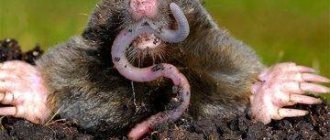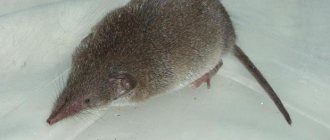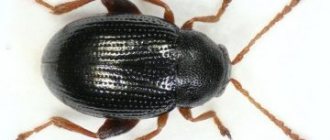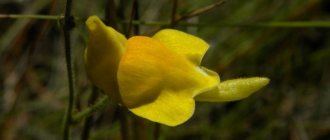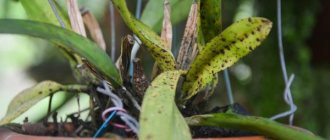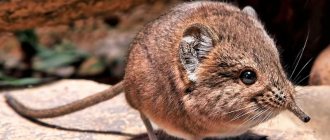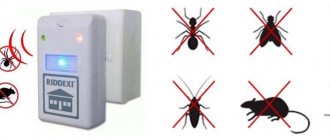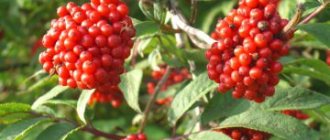Before you grab all the means to combat furry pests, compare the harm they cause with the benefits they bring. For example, they loosen the soil and thereby improve its fertility. But if this is a weak argument, we are ready to suggest several effective ways to protect your garden from these uninvited guests.
Shrews, wild hamsters, mole rats and the like have quite a lot in common. For example, they have a well-developed sense of smell, as well as sensitivity to noise and vibration. They are also quite voracious. All these features of furry pests need to be turned to your advantage by using appropriate means of protection.
Destruction of pest holes
If the hole is not very deep, you can try to dig it out or even flood it. Experts say that young animals and pregnant individuals will immediately begin to leave the hole. But in order to prevent the “furry residents” from returning, you will have to deal with them at the exit from their habitats.
Some experienced gardeners advise filling holes with cat litter or even dog excrement. And it’s true: if you have decided to wage a constant battle with furry pests, then all means are good. You can even fill the holes with rotten fish - then instead of animals you risk finding an unforgettable “amber” spreading throughout the entire area.
- 5 proven ways to fight moles from our readers
Tired of looking for an effective remedy for moles in the country? And our readers found, and not just one, but several at once.
Damage caused
Although the shrew's main diet is insects, it does not mind pampering itself with the fruits of human labor - root vegetables - in particular beets, carrots, roots and seeds of other crops.
Therefore, if a vegetable garden, cottage or garden plot is occupied by these small animals, it is important to urgently take action and expel them or destroy them.
An interesting fact is that pests live individually, not in groups. Each animal has its own designated territory of up to 800 square meters. meters.
Pest control using strong odors
Using a smoke bomb or other similar devices, smoke is released as deep as possible into the burrows of the animals. Those who have used this method claim that they leave the site for a long time.
A less effective, but still good way is to use repellent natural odors. Repellent plants have such aromas - for example, marigolds, narcissus, legumes, garlic or milkweed. Growing them near burrows will help repel furry pests for a while before you find a more effective remedy.
Reviews from gardeners
Konstantin, 64 years old, Rostov
The simplest methods helped to scare away shrews from a summer cottage: acoustic and “aromatic”. Before the autumn digging of the garden, dried marigolds crushed into dust were scattered, and rags soaked in turpentine were buried along the entire border of the plot. Pieces of rotten fish were placed in the holes. In case the shrews bypassed the bait, additional metal reinforcement was dug into the garden bed at a slight angle to the ground, to a depth of 40-50 cm. A plastic bottle was placed on it, which moved with a light blow of wind, and the noise from the vibration of the steel rod scared away the animals. Champagne bottles, also at an angle, were buried in the ground - the effect was the same - an unbearable roar was heard.
Veronica, 56 years old, Ryazan region
In the garden plot we did not decide to use poison or traps for humane reasons, so we save ourselves from shrews using the Grad ultrasonic device. I insert batteries into the device, seal it in a plastic bag and dig it near the holes to a depth of 10 cm. After 2-3 weeks I observe the complete disappearance of the pest. At the same time, ultrasonic waves do not have a harmful effect on animals and people.
Semyon, 48 years old, Krasnodar region
In my apiary in mid-November, a shrew got into the habit of emptying the hives. It is more dangerous than ordinary mice because it is small and very voracious. To drive it away, I placed a fine-mesh (size 6 mm) grate between the bottom and the lower body, but the tight holes prevented the bees from exiting. In March I replaced it with a mesh with 8-10 mm cells. In addition, I cleaned the hives of dirt and placed a pollen collector on the entrance. After that, all the problems with pests disappeared.
“Edible” folk remedies for pests
All of the above methods of dealing with uninvited guests, of course, also apply to folk methods. However, we decided to collect into a separate group those of them that our readers showed particular ingenuity in coming up with. Note that all these remedies are somehow related to the digestion of furry pests.
- Wood ash. It is poured into the holes of animals, and the alkali it contains corrodes their paws and forces them to lick the ash. Well, when ingested, it provokes the same reaction in the stomach of furry pests, which become uncomfortable with such a habitat - and they leave it.
- Ground repellent plants. Sowing them didn't help? Pick them, chop them up and put them in holes. To enhance the effect, experienced summer residents recommend combining several of these plants in one mixture.
- Bread and wine stopper. Both are crushed into pieces and combined with a small amount of vegetable oil. The bait is then placed in the habitats of the furry pests. Such “food” gets stuck in their intestines and the animals die.
- Quicklime and sugar. Have the same effect as the combination above. Before using this “duet”, its components are mixed and poured into the minks of the animals that they want to get rid of once and for all.
- Flour, alabaster and water. The imagination of the people in the fight against annoying pests knows no bounds, and everything that is at hand is used. Of course, you shouldn’t mix all three components with each other. Simply combine flour with alabaster, pour this mixture into a bowl and leave it near the animals’ holes. And place a bowl of water next to it. After dining on the mixture, they will certainly want to drink. Well, then a fairly well-known reaction will occur in their stomachs, after which they, of course, will not survive.
Distinctive features of shrews and habitat
For shrews to appear on a summer cottage, certain conditions are required. They choose well-moistened soil, since the hard soil does not allow them to dig even shallow holes with narrow earthen passages. Therefore, animals prefer shaded places with dense vegetation near bodies of water or in areas that are watered on a regular basis. If there is a greenhouse in the garden, then the shrew will definitely get inside through the underground labyrinths.
Animals use dry leaves and branches to insulate their underground nests
Shrews make their nests underground from dry branches and leaves, as a rule, in other people's burrows, free from their previous owners - moles, mole rats and field mice. At the same time, the animals stay apart and militantly defend the boundaries of their territory from their relatives. Special glands secrete a pungent musky odor , which allows them to repel natural enemies (the exceptions are owls, ferrets and weasels).
Researchers have discovered a strange, unique ability of shrews, the so-called “Denel effect,” when in the fall young animals experience a decrease in body size and a flattening of the skull. This phenomenon is due to the fact that in winter they do not hibernate, and the volume of their usual food is reduced. From April to June, body parameters increase to their previous sizes.
An animal eats an amount of food equal to its own weight in three hours, and dies from seven-hour hunger.
Voracity is directly related to the small size of these warm-blooded animals
Maintaining a constant body temperature and accelerated metabolism force animals to spend time around the clock in search of food , taking a short break to sleep. Their day is divided not into day and night, but into periods for sleeping and hunting. Different species of shrews have their own days: some divide them into 10 periods, others, for example, the shrew, go to bed 78 times in 24 hours and wake up the same number of times in order to get food for themselves.
In spring and summer, the diet of these predators includes a large number of beetles and their larvae, other insects and earthworms; they can also attack frogs, lizards and young small rodents. In winter, even under the snow, they find sleeping insects and plant seeds.
Harm and benefit
Whether it is necessary to get rid of the presence of these animals on the site is an open question, since the real benefits they bring are obvious, and each gardener can assess the harm they cause in their own way. In order not to engage in lengthy reasoning, we present the main arguments in the table:
| Benefit | Harm |
| They destroy beetles, slugs, parasite larvae and other harmful insects that live underground in hard-to-reach places. They fertilize and loosen the soil, which saturates it with oxygen. Destroy small rodents - mice. Do not eat underground parts of plants | They damage the root systems of cultivated plants and leave a large number of burrows due to active movement through underground passages in search of food. |
Beneficial pollinating insects, such as bees, also suffer from shrews - a nimble insectivore can destroy up to four bees in an hour
If you still intend to fight these small predators, then they can not only be exterminated with the help of pesticides. There are many other, humane ways to drive away or scare away animals.
Zoocides against pests
The logical conclusion of our article is products specifically designed to combat furry pests. They are the most effective, although people call them poison and “chemistry”. These are drugs such as Ratobor, Varat, Antikrys, Last Breakfast, Storm, Bros. By the way, some of them are harmless to people and pets, for example, Mole Meter ECO.
By the way, if the listed options do not suit you, opt for another type of industrial means against furry animals - an ultrasonic repeller. Due to its low frequency, the sound produced is heard only by pests. This sound scares them - and they leave. How do you drive them away?
Pesticide
You will achieve better results in the fight against the animal by using both chemical and mechanical methods (traps). Modern poisons are very effective and kill parasites almost immediately, causing suffocation.
Today the following chemical preparations are on the market - “Rat Death”, “Hunter Anti-Rodent”, “Nutcracker”, etc. Read the instructions carefully so as not to harm yourself. However, it is clear that this method is inhumane.
Take precautions and ensure that children or pets do not find the bait!
Video
Experienced gardeners share educational information about the life activity of shrews and ways to repel these insectivores in the following videos:
His main specialty is an accountant, so even at his dacha he strives for accuracy and achieving ideal order in everything. Preference is given to growing grapes. I am sure that the deeper you delve into gardening and gardening, the more you understand that there is no limit to perfection!
Found a mistake? Select the text with the mouse and click:
Tomatoes have no natural protection against late blight. If late blight attacks, any tomatoes (and potatoes too) die, no matter what is said in the description of the varieties (“variety resistant to late blight” is just a marketing ploy).
Humus is rotted manure or bird droppings. It is prepared like this: the manure is piled up in a heap or pile, layered with sawdust, peat and garden soil. The pile is covered with film to stabilize temperature and humidity (this is necessary to increase the activity of microorganisms). The fertilizer “ripens” within 2-5 years, depending on external conditions and the composition of the feedstock. The output is a loose, homogeneous mass with a pleasant smell of fresh earth.
Natural toxins are found in many plants; Those grown in gardens and vegetable gardens are no exception. Thus, the seeds of apples, apricots, and peaches contain hydrocyanic acid, and the tops and peels of unripe nightshades (potatoes, eggplants, tomatoes) contain solanine. But do not be afraid: their number is too small.
The homeland of pepper is America, but the main breeding work on developing sweet varieties was carried out, in particular, by Ferenc Horvath (Hungary) in the 20s. XX century in Europe, mainly in the Balkans. Pepper came to Russia from Bulgaria, which is why it received its usual name - “Bulgarian”.
“Frost-resistant” varieties of garden strawberries (more often simply “strawberries”) need shelter just as much as ordinary varieties (especially in those regions where there are snowless winters or frosts alternating with thaws). All strawberries have superficial roots. This means that without shelter they freeze to death. Sellers’ assurances that strawberries are “frost-resistant,” “winter-hardy,” “tolerates frosts down to −35 ℃,” etc. are deception. Gardeners must remember that no one has yet managed to change the root system of strawberries.
From varietal tomatoes you can get “your own” seeds for sowing next year (if you really like the variety). But it is useless to do this with hybrids: you will get seeds, but they will carry the hereditary material not of the plant from which they were taken, but of its numerous “ancestors”.
You need to collect medicinal flowers and inflorescences at the very beginning of the flowering period, when the content of nutrients in them is highest. Flowers are supposed to be picked by hand, tearing off the rough stalks. Dry the collected flowers and herbs, scattered in a thin layer, in a cool room at natural temperature without access to direct sunlight.
It is believed that some vegetables and fruits (cucumbers, stem celery, all varieties of cabbage, peppers, apples) have “negative calorie content,” that is, more calories are consumed during digestion than they contain. In fact, only 10-20% of the calories received from food are consumed in the digestive process.
Both humus and compost are rightfully the basis of organic farming. Their presence in the soil significantly increases the yield and improves the taste of vegetables and fruits. They are very similar in properties and appearance, but they should not be confused. Humus is rotted manure or bird droppings. Compost is rotted organic remains of various origins (spoiled food from the kitchen, tops, weeds, thin twigs). Humus is considered a higher quality fertilizer; compost is more accessible.
Source
Traps
A good trap for shrews is a mousetrap, in which you need to put some kind of pleasant-smelling bait.
You can make such a device with your own hands from a pipe or wire:
- Wire trap . The spacer is installed near the entrances to the tunnels; at the slightest touch, the fixation mechanism will work. An animal caught in a trap can be thrown out, and then the trap can be set again. You can charge the spacer until there is not a single shrew left in the garden.
- A trap made of a small-diameter pipe , on both edges of which it is necessary to construct shutters. When the shrew smells the fragrant bait and pokes its head into the gate, the gate will open slightly. Nothing will prevent the pest from getting inside, but it will no longer be able to get out (the shutters must be closed inward).
Traps equipped with sharp rods are not as humane as previous examples of traps. When the mechanism is triggered, these rods kill the pest by piercing its body with these spokes.
